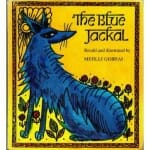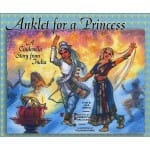 I asked several of my former colleagues what type of Indian stories their students liked. One responded, the Panchatantra. Huh, was my initial response. Yes, even after living in India for 8 months, I admit that my understanding of Indian culture is limited. A Google search came in handy.
I asked several of my former colleagues what type of Indian stories their students liked. One responded, the Panchatantra. Huh, was my initial response. Yes, even after living in India for 8 months, I admit that my understanding of Indian culture is limited. A Google search came in handy.
The Panchatantra is a 5 book anthology of stories originally passed down orally and then later written in Sanskrit between the 3-5th century CE. This collection of famous animal fables and magic tales focuses on wise conduct.
At the library, I stumbled upon the classic tale, The Blue Jackal retold and illustrated by Mehlli Gobhai (Prentice Hall, Inc. 1968) Until I sat down to read the book, I didn’t realize that it was published over 40 years ago. The excellent condition of the binding suggests a limited amount of readership.
When it comes to fables or folktales, the age of the book may only affect the aesthetic appeal of the pictures or the graphics. In this case, the rotation of simple colored pictures with black and white illustrations may lessen the appeal to this timeless story about a shy jackal whose personality is transformed after being unintentionally coated with indigo dye. A quick Amazon search revealed that used copies can be purchased for a penny along with some other stories retold by Mehlli during the 60s and the 70s.
I tried to find background information on this author/illustrator but came up empty handed. There is a notable Indian artist with the same name. Does anyone know if it is the same person?
Like most Americans, my public school education included only a smattering of information pertaining to India or Hinduism. While living in India, I experienced the vitality of an amazing culture. I will never forget being in New Delhi with my son, Josh and his fiancé, Rachael, during my Diwali break. If I had read a simple picture book such as the ones listed below, I may have felt less ignorant at the start of the festival.
Lights for Gita by Rachna Gilmore, Illustrated by Alice Priestley (Tilbury House, Publishers, 1994) is another out-of-print book that allows young readers to connect with the universal themes associated with being a new immigrant in a strange environment and the desire to maintain one’s cultural identity. The main character, Gita, misses the traditions associated with Diwali, a Hindu fall festival. The author contrasts the gloomy Northern Hemisphere climate with the radiance associate with India’s Festival of Lights. A simple nonfiction book like Lighting a Lamp: A Diwali Story by Jonny Zucker and illustrated by Jan Barger (Barrons Educational Series) or a more detailed book, The Story of Divaali retold by Jatinder Verma and illustrated by Nilesh Mistry are additional nonfiction resources. Diwali is oftentimes compared to the Jewish winter festival, Chanukah. Immigrants from all cultures can relate to Gita’s desire to remain connected to her heritage.
Ethnic groups have rich treasure troves of fairy tales, folk tales, myths, and legends. Some stories have universal themes that appear in multiple countries. Anklet for a Princess: A Cinderella Tale from India by, Lila Mehta Adapted by Meredith Brucker and Illustrated by, Youshan Tang (Shen’s Books, 2002) is one such example.
that appear in multiple countries. Anklet for a Princess: A Cinderella Tale from India by, Lila Mehta Adapted by Meredith Brucker and Illustrated by, Youshan Tang (Shen’s Books, 2002) is one such example.
A unit on Cinderella stories would not be complete without this adaptation of the Indian version of “Nagami”, Jewel of the Snake. This story, estimated to be over 1000 years old, was initially handed down from one generation to the next by word of mouth. A mystical snake is the force behind changing an abused stepchild into a beautiful princess. The vibrant water color illustrations created by Chinese artist, Youshan, illuminates the key aspects of the story. Using a Venn Diagram, students could articulate the similarities and differences between the more familiar European version and this one.
Nice blog, Sandy. Interesting entries. Much luck with this endeavor. Is there a Blog of the Year contest? 🙂
Dottie,
I’m glad that you enjoyed the blog and thanks for your words of encouragement.
It is the same Mehlli Gobhai. He is a friend and we are about to organise a huge retrospective of his work.
Jerry, Can you share more about the project that you mentioned?